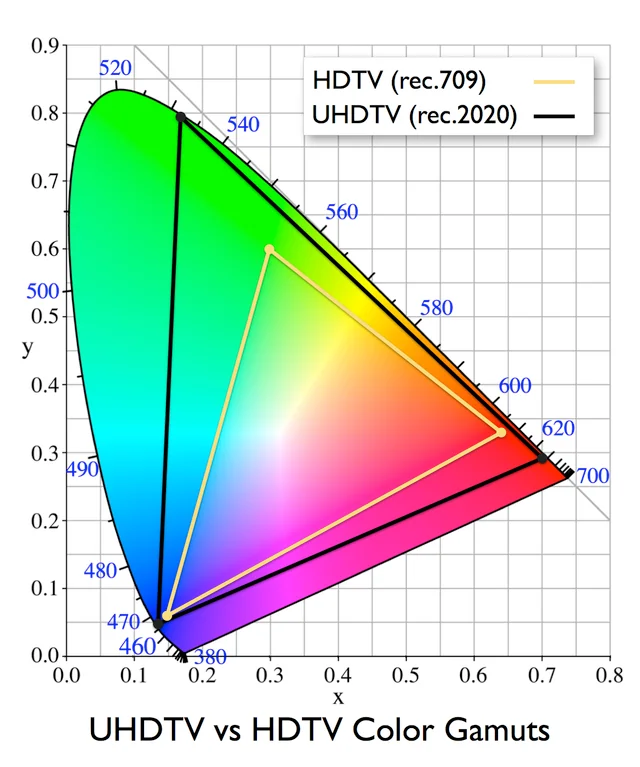[en] Color Space
[en] An overview of Color Space and how it applies to Quasar Science fixtures
[en] There are two main color standards that are common in photography and lighting. Those are the CIE 1931 and CIE 1976 coordinate systems of color, named for the years in which they were published so they've been with us for quite a while. CIE is a long-standing organization who's acronym comes from its full French name: Commission internationale de l’éclairage.
[en] For the purpose of this overview we will reference the CIE 1931 color system, which was developed as a color-matching system that uses numerically-specified values (coordinates) for each color that is visible to humans so that those measured values could be referenced to reproduce that same color in other situations.
[en] This coordinate system give us a backdrop to visualize the color spectrum using "x" and "y" coordinates when working with light.
 |
[en] There is a 1976 revision that contains the same information but is scaled differently. For the purposes of this article we willl use the 1931 chart since it is most ubiquitous color picker when referencing CIE.
[en] If the chart above represents the totality of visible color to our eyes, you can state this as the "full gamut" of color and makes use of the xy coordinate system for color matching between lights. When your lighting fixture is capable of accepting xy values, you should be able to reproduce approximate colors from CIE coordinates across your lights. This does depend on how well their color engines reproduce a given color. They are not all equal.
[en] Each piece of technology in the camera and lighting industries can achieve a portion of this "full gamut" range of colors and that range is simply called "gamut". This is usually represented by a triangle overlay on the CIE 1931 chart that shows what range of color a light, or computer monitor or a camera is capable of reproducing.
[en] As you can see the Rec709 gamut is a fairly small section of the visible color range but has been used for along time since it covered the needs of many applications with display monitors. That D65 dot defines the White Point of the Color Space. When R,G,B are at Full the white light produced is 6500K, which can be equated to natural daylight.
[en] The Rec709 gamut is used with HD (High Definition) video starting in 2006 with Blu Ray discs. This was a step up from the original NTSC standard with Cathode-Ray tubes of the 70's and interleaved scan lines of VHS video tapes. While it was a "standard", NTSC became colloquially known as "Never The Same Color".
[en] In 2015 Blu Ray moved to UHD (Ultra High Definition) and is known as 4K, which uses up to 4096x2160 pixels and a wider color gamut referred to as Rec2020.
 |
[en] Compared to Rec709, a Rec2020 gamut can produce a much wider range of color within the CIE color space.
[en] As an example: When working in a production format that requires attention to color space if you're using a fixture and its produce-able color range is beyond the range of the camera system, you will quickly be asked to desaturate the selected color until it comes within the triangle of the working gamut.
[en] Quasar Science fixtures build in this capability with our pixel mapping profiles which contain the Color Space parameter.
[en] Color Space | [en] Gamut | [en] Color Engine |
|---|---|---|
[en] Rec709 | [en] Rec709 | [en] Relative Colorimetric |
[en] sRGB | [en] sRGB | [en] Relative Colorimetric |
[en] sRGB Linear | [en] sRGB | [en] Relative Colorimetric |
[en] RGBX | [en] RGBX | [en] Absolute Hue |
[en]
[en] Currently there are (3) Color Spaces available on the RR-R2 fixtures. These are RGBX, Rec709 and sRGB. Rec709 is generally used with Camera and Editing systems. sRGB is the display version of Rec709 for monitors and video displays and you will see that their gamut charts are practically identical.
![[en] Rec709 comparison for the RR100](image/img-1d9b1324a9cf873e52b8a1b5f9852310.jpg) |
[en] Using the full spectrum available with are RGBTD diodes, we can set the fixture to output color within the Rec709 color space
[en] With RR & R2 fixtures you can select the desired Color Space with the DMX parameter and the fixture will output colors calculated for the selected gamut. If you are currently using a wide-gamut color space then you can take advantage of our RGB VW profiles which are closer to the Rec2020 range of color with our RGBX Color Space.
[en] RGBX is Quasar Science's own native gamut that maximizes Saturation and Brightness and is the normal operating mode of our fixtures. We are working on adding additional color spaces such as ACES and Rec2020 for new camera systems and workflows.
Astuce
[en] See our >DMX Charts< for information on available profiles and color space